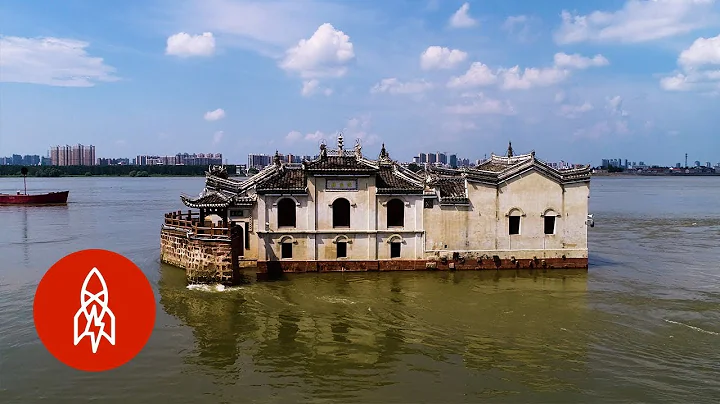
Buildings in ancient times were born with myths and stories. Because of these myths and stories, these buildings also appear to be particularly valuable and mysterious. This is the case with the "Guanyin Pavilion" located in the center of the Yangtze River. This "nail house" that has occupied the Yangtze River for more than 700 years has a very well-known past and is protected by the state. Because of its mysterious color, no one has dared to demolish it for thousands of years. It has been weathered and has a panoramic view of the Yangtze River. Every flood tide floods the pavilion, leaving only the high-rise windows and even the eaves, dragon's kiss and middle pavilion in the vast Yangtze River. But afterwards it was as good as ever, as it had been for thousands of years. (Picture from Oriental IC)

Guanyin Pavilion was first built in the Song Dynasty, rebuilt in the fifth year of Zhizheng in the Yuan Dynasty (1345), and rebuilt many times in the Ming and Qing Dynasties. The pavilion faces east and faces west. A stone platform is built on the reef, and the pavilion is built on the platform. The pavilion is 24 meters long and 14 meters high. It is built with red stone and blue bricks and is cleverly integrated with Longpanji. It looks majestic and majestic. For thousands of years, it has gone through many hardships and has a panoramic view of the Yangtze River. Therefore, it is also known as "the first pavilion on the Yangtze River". (Picture from Oriental IC)

In the 1930s, the government of the Republic of China rebuilt the Guanyin Pavilion that everyone sees now. However, after the reconstruction, it was still not immune to the Yangtze River floods. It was still flooded every few years. During the largest flood, the river water There is no roof. With the completion of the Three Gorges damming project, the Guanyin Pavilion in the middle of the river was truly spared. "Guanyin Pavilion" has three powerful characters "Guanyin Pavilion" engraved on the main wall of the pavilion. The four characters "Dragon Pan Xiaodu" engraved on the stone tablet at the main entrance of the pavilion are from official writings of the Qing Dynasty. (Picture from Oriental IC)

From west to east, there are Guanlan Pavilion, Dongfang Shuo Hall, Guanyin Hall, Laojun Hall and Chunyang Tower. On the Guanlan Pavilion, you can overlook the river, and the scenery is majestic; in the three-story hall, you can look up to the sages and write brilliant articles. Lu Dongbin was sleeping soundly on the upper floor of Chunyang Tower. When visitors came here, they all stopped to hold their breath and smiled knowingly: How can such a fairyland like Penglai be the only place it deserves? (Picture from Oriental IC)

The curved stones on the left and right sides, which look like ship rails, not only slow down the water flow, but also release it smoothly. No matter how the river water slaps and roars, it will always remain stable. The ancient Ezhou craftsmen's wonderful use of fluid mechanics and the unique style of plastic art have made many architectural experts stop and marvel. (Picture from Oriental IC)

Several ancient trees on the stone wall, which had withered and shrunk for many years, have come back to life in recent years and are spreading their young branches to embrace the arrival of spring. The old well in the pavilion has had clear water since ancient times. The water level is several feet higher than the river water, which is amazing. The old well, the ancient tree and the divine turtle eye are called the "three interests" of Guanyin Pavilion. There are also some myths and stories connected with "Guanyin Pavilion". There is a saying circulating in Ezhou: "As long as Guanyin Pavilion is flooded, Ezhou will be flooded." (Picture from Oriental IC)

According to legend, Guanyin Bodhisattva traveled around and came to the city of Wuchang. When he saw that the rivers here were overflowing and the people were suffering from floods, he asked the Jade Emperor to send troops to guard him. The Jade Emperor then sent a decree to the Dragon King of the East China Sea, and the Dragon King punished Hai Ao. Go to. After receiving the order, Hai Ao went up the Yangtze River and settled in the middle of the river at the north gate of Wuchang County. He glared at the river with a pair of giant eyes and rose and fell with the river. Due to Shen Ao's care, the river was indeed overflowing. Decreasing year by year. In order to commemorate the Dragon King and express gratitude to Guanyin Bodhisattva, later generations built a temple on Longpanji and named it Guanyin Pavilion. (Picture from Oriental IC)

There are also two stone mortars on Longpanji. It is said that they are the two eyes of Shen Ao, one produces oil and the other produces salt. Later, a greedy Taoist priest in the pavilion used a chisel to enlarge the diameter of the concave hole several times in an attempt to extract more oil and salt. Unexpectedly, Shen'ao was blinded. From then on, the two mortars on Longpanji no longer produced oil and salt, and the Guanyin Pavilion standing on Shen'ao's head no longer rose or fell with the river. (Pictures from Oriental IC)

The "Guanyin Pavilion" that has survived 700 years of erosion and floods, on the one hand, illustrates the wisdom of the ancient people of the great Chinese nation, and on the other hand, it may also have "this aspect of factors."But no matter what, this kind of building that has stood in the water for thousands of years truly reflects the wisdom and greatness of the Chinese people. In the history of architecture, it can be called a miracle. What do you think? (Picture from Oriental IC)











![[Cross-Strait Quick Review Issue 375] In September, the "prosperity light" on the island showed the ninth yellow and blue light that represents a weakening trend, which means that the island's economy has been in a downturn in the first nine months of this year. The prosperity li - DayDayNews](https://cdn.daydaynews.cc/wp-content/themes/begin/img/loading.gif)









